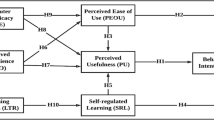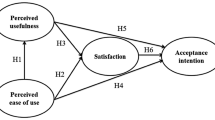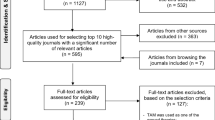Abstract
The study builds on a newly modified Technology Acceptance Model (TAM) to substantiate the motivation and operation of teachers’ utilization of online learning resources. A ‘Comprehensiveness’ construct is proposed in the modified TAM to reflect the breadth and depth of rich online knowledge. This new construct serves as the mediator between ‘Usefulness’ and ‘Behavioral Intention’ in the new TAM structure. In addition, the ‘Ease of Use’ factor in conventional TAM is proposed to moderate the mediation in the modified TAM. Survey data are collected from 301 teachers undertaking certified training in Macau and Structural Equation Model (SEM) technique is used to assess the model. Moderated mediation is evaluated using both multi-group bootstrapping method and moderated path analysis method. Both methods verify the presence of moderated mediation with partial mediation in high Ease of Use values and full mediation in low Ease of Use values. Theoretical implication of the current study extends the coverage of TAM applications and academic implication suggests the strengthening in teachers’ professional development and government sponsorship in building repositories of online resources.





Similar content being viewed by others
Explore related subjects
Discover the latest articles, news and stories from top researchers in related subjects.References
Abrams, S., & Walsh, S. (2014). Gamified vocabulary: online resources and enriched language learning. Journal Of Adolescent And Adult Literacy, 58(1), 49–58.
Ahmad, T., Madarsha, K., Zainuddin, A., Ismail, N., & Nordin, M. (2010). Faculty's acceptance of computer based technology: cross-validation of an extended model. Australasian Journal of Educational Technology, 26(2), 268–279.
Alias, N., DeWitt, D., & Siraj, S. (2014). An evaluation of gas law webquest based on active learning style in a secondary school in Malaysia. Eurasia Journal Of Mathematics, Science And Technology Education, 10(3), 175–184.
Angelova, M., & Zhao, Y. (2016). Using an online collaborative project between American and Chinese students to develop ESL teaching skills, cross-cultural awareness and language skills. Computer Assisted Language Learning, 1, 167. doi:10.1080/09588221.2014.907320.
Arbaugh, J. (2000). Virtual classroom characteristics and student satisfaction with internet-based MBA courses. Journal of Management Education, 24, 32–54.
Aypay, A., Coşkun Çelik, H., Aypay, A., & Sever, M. (2012). Technology acceptance in education: A study of pre-service teachers in Turkey. Turkish Online Journal Of Educational Technology, 11(4), 264.
Baron, R., & Kenny, D. (1986). The moderator–mediator variable distinction in social psychological research: conceptual, strategic, and statistical considerations. Journal of Personality and Social Psychology, 5, 1173–1182.
Chen, J. (2010). Investigating models for preservice teachers’ use of technology to support student-centered learning. Computers & Education, 55, 32–42.
Chen, H., & Tseng, H. (2012). Factors that influence acceptance of web-based e-learning systems for the in-service education of junior high school teachers in Taiwan. Evaluation and Program Planning, 35, 398–406.
Clements, M., Pazzaglia, A., Zweig, J. (2015). Regional Educational Laboratory Northeast & Islands, Education Development Center & National Center for Education Evaluation and Regional Assistance. (2015). Online Course Use in New York High Schools: Results from a Survey in the Greater Capital Region. REL 2015–074. Stated Briefly. Regional Educational Laboratory Northeast & Islands, (March 1, 2015): ERIC, EBSCOhost
Cornelius, S., & Gordon, C. (2009). Adult Learners' use of flexible online resources in a blended Programme. Educational Media International, 46(3), 239–253.
Crook, C., & Harrison, C. (2008). Web 2.0 technologies for learning at Key Stages 3 and 4: Summary report. Retrieved 15th March, 2015 from http://dera.ioe.ac.uk/1480/1/becta_2008_web2_summary.pdf
Curriculum Development Council. (2000). Information technology learning targets. Retrieved 15th March, 2015 from http://www.edb.gov.hk/en/curriculum-development/4-key-tasks/it-for-interactive-learning/it-learning-targets/index.html
Davis, F. (1989). Perceived usefulness, perceived ease of use, and user acceptance of information technology. MIS Quarterly, 13(3), 319–340.
Dhatt, K., & Kaliaperumal, C. (2014). Incorporation of web-based applications and online resources in undergraduate medical education in the Irish Republic. Can new changes be incorporated in the current medical curriculum? Journal Of Natural Science. Biology & Medicine, 5(2), 445–449.
Dringus, L. (2008). Editor's choice 2008: Selected online learning resources. The Internet And Higher Education, 11(Special Section of the AERA Education and World Wide Web Special Interest Group (EdWeb/SIG), 211–216
Edwards, J., & Lambert, L. (2007). Methods for integrating moderation and mediation: a general analytical framework using moderated path analysis. Psychological Methods, 12(1), 1–22.
Gibson, S., Harris, M. L., & Colaric, S. (2008). Technology acceptance in an academic context: faculty acceptance of online education. Journal of Education for Business, 83(6), 355–359.
Goh, W., Hong, J., & Gunawan, W. (2014). Exploring Lecturers' perceptions of learning management system: an empirical study based on TAM. International Journal Of Engineering Pedagogy, 4(3), 48–54.
Gunderson, M. (2013). Learn the alphabet, Retrieved 15th March, 2015 from http://www.learnthealphabet.org
Gunzler, D., Tian, C., Pan, W., & Hui, Z. (2013). Introduction to mediation analysis with structural equation modeling. Shanghai Archives Of Psychiatry, 25(6), 390–394.
Hair, J., Black, W., Babin, B., & Anderson, R. (2010). Multivariate data analysis (seventh ed.). New Jersey: Prentice-Hall/Pearson Education.
Hancock, G., & Mueller, R. (2006). Structural equation modeling: a second course. Greenwich, CT: IAP
Hegelheimer, V. (2006). Helping ESL writers through a multimodal, corpus-based, online grammar resource. CALICO Journal, 24(1), 5–32.
Henry, L. (2005). Information search strategies on the internet: A critical component of new literacies. Webology, 2(1), Article 9
HKedCity (2015). Department of Education One Stop Platform for Education. Retrieved 15th March, 2015 from http://www.hkedcity.net/edbosp
Hu, L., & Bentler, P. (1999). Covariance Structure Analysis: Conventional Criteria Versus New Alternatives. Structural Equations Modeling, 6(1), 1--55.
Hughes, H. (2013). International students using online information resources to learn: complex experience and learning needs. Journal Of Further & Higher Education, 37(1), 126.
Jenkinson, P. (2015). Discover online teacher resources that help bring Australian stories to life. Access (10300155), 29(4), 14–17.
Kenny, D., & McCoach, D. (2003). Effect of the number of variables on measures of fit in structural equations modeling. Structural Equations Modeling, 10(3), 333–351.
Kline, R. (2005). Principles and practice of structural equation modeling (2nd ed.). New York: Guilford Press.
Laetitia, B., & Ghislaine, G. (2009). Online resources in mathematics, teachers’ geneses and didactical techniques. International Journal of Computers for Mathematical Learning, 14(1), 1.
Lazaros, E., & Bormann, C. (2013). Leveraging online resources to promote inquiry and STEM in elementary schools. Children's Technology & Engineering, 18(2), 12–15.
Lederer, A., & Maupin, D. (2000). The technology acceptance model and the world wide web. Decision Support Systems, 29(3), 269.
Lee, D., & Lehto, M. (2013). User acceptance of YouTube for procedural learning: an extension of the technology acceptance model. Computers & Education, 61, 193–208.
Lim, C. (2007). Effective integration of ICT in Singapore schools: pedagogical and policy implications. Educational Technology Research and Development, 55, 83–116.
Liu, F., Chen, M., Sun, Y., Wible, D., & Kuo, C. (2010). Extending the TAM model to explore the factors that affect intention to use an online learning community. Computer & Technology, 54(2), 600–610.
MacCallum, R., Zhang, S., Preacher, K., & Rucker, D. (2002). On the practice of dichotomization of quantitative variables. Psychological Methods, 7, 19–40.
MacKinnon, D., Warsi, G., & Dwyer, J. (1995). A simulation study of mediated effect measures. Multivariate Behavioral Research, 30, 41–62.
Marklund, L. (2015). Preschool teachers’ informal online professional development in relation to educational use of tablets in Swedish preschools. Professional Development In Education, 41(2), 236. doi:10.1080/19415257.2014.999380.
McClain, J. (2009). 5 Best Websites For Space and Astronomy Fans, Retrieved 15th March, 2015 from http://www.makeuseof.com/tag/5-best-websites-for-space-and-astronomy-fans
McDonald, R., & Ho, R. (2002). Principles and practice in reporting structural equation analyses. Psychological Methods, 7, 64–82.
McMartin, F., Iverson, E., Wolf, A., Morrill, J., Morgan, G., & Manduca, C. (2008). The use of online digital resources and educational digital libraries in higher education. International Journal on Digital Libraries, 9(1), 65–79.
Moore, J., & Chae, B. (2007). Beginning teachers' use of online resources and communities. Technology, Pedagogy and Education, 16(2), 215–224.
Muir, T. (2014). Google, Mathletics and khan academy: students' self-initiated use of online mathematical resources. Mathematics Education Research Journal, 26(4), 833.
Ndubisi, N. O. (2005). Integrating the moderation effect of entrepreneurial qualities into the tam model and treatment of potential confounding factors. Journal Of Information Science & Technology, 2(1), 28–48.
Osman, K. (2014). Evaluation of webquest in biology: Teachers' perception. Turkish Online Journal Of Distance Education, 15(1), 89–98.
Park, S. (2009). An analysis of the technology acceptance model in understanding university student’s behavioural intention to use e-learning. Educational Technology & Society, 12(3), 150–162.
Park, S., Nam, M., & Cha, S. (2012). University students' behavioral intention to use mobile learning: evaluating the technology acceptance model. British Journal of Educational Technology, 43(4), 592–605.
Pellerin, M., & Montes, C. S. (2012). Using the Spanish online resource "aula virtual de Espanol" (AVE) to promote a blended teaching approach in high school Spanish language classrooms. Canadian Journal of Learning and Technology, 38(1).
Podsakoff, P., MacKenzie, S., Lee, J., & Podsakoff, N. (2003). Common method biases in behavioral research: a critical review of the literature and recommended remedies. Journal of Applied Psychology, 88(5), 879.
Preacher, K., & Hayes, A. (2004). SPSS and SAS procedures for estimating indirect effects in simple mediation models. Behavior Research Methods, Instruments, & Computers, 36, 717–731.
Ramaswamy, R., Leipzig, R., Howe, C., Sauvigne, K., Usiak, C., & Soriano, R. (2015). The portal of geriatrics online education: a 21st-century resource for teaching geriatrics. Journal of the American Geriatrics Society, 63(2), 335–340. doi:10.1111/jgs.13246.
Roberts, D. (2015). Links to Calculus Materials and Resources, Retrieved 15th March, 2015 from http://mrsroberts.com/MrsRoberts/Calculus/calculus.htm
Roy, D., Sarkar, S., & Ghose, S. (2010). A comparative study of learning object metadata, learning material repositories, metadata annotation & an automatic metadata annotation tool. Vol. 2. Joshi, M., Boley, H. & Akerkar, R. (Eds.), Advances in Semantic Computing. TMRF e-book series.
Segars, A. (1997). Assessing the unidimensionality of measurement: a paradigm and illustration within the context of information systems research. Omega International Journal of Management Science, 25(1), 107–121.
Seyedarabi, F. (2011). Personalization: an emerging direction for tackling the web searching barriers faced by teachers when searching for educational resources. Webology, 8(2), 1–24.
So, W., & Ching, F. (2012). Online resource-based learning environment: case studies in primary classrooms. Asia-Pacific Forum On Science Learning And Teaching, 13(2), n2.
So, W., Cheng, M., Ching, N., & Kong, S. (2014). Views of primary science teachers towards the use of online resources to support the implementation of inquiry learning. Education 3–13, 42(4), 386–401.
Song, Z., Su, X., & Li, L. (2013). The indirect effects of destination image on destination loyalty intention through tourist satisfaction and perceived value: the bootstrap approach. Journal Of Travel And Tourism Marketing, 30(4), 386–409.
Tarhini, A., Hone, K., & Liu, X. (2014). Measuring the moderating effect of gender and age on E-learning acceptance in England: a structural equation modeling approach for an extended technology acceptance model. Journal of Educational Computing Research, 51(2), 163–184.
Teacher Corner (2015). Teacher’s resource repository. Retrieved 15th March, 2015 from http://portal.dsej.gov.mo/www/portalspace/discuz/dsej_getcontent_page.php?con=portalspace/teachmai/resource/main.html
Teo, T. (2009). Modelling technology acceptance in education: a study of pre-service teachers. Computers & Education, 52, 302–312.
Thompson, R., Higgins, C., & Howell, J. (1991). Personal computing: toward a conceptual model of utilization. MIS Quarterly, 15(1), 124–143.
Wegener, D., & Fabrigar, L. (2000). Analysis and design for nonexperimental data: addressing causal and noncausal hypotheses. In H. T. Reis & C. M. Judd (Eds.), Handbook of research methods in social and personality psychology (pp. 412–450). New York: Cambridge University Press.
Wong, K., Osman, R., Goh, P., & Rahmat, M. (2013). Understanding student Teachers' behavioural intention to use technology: technology acceptance model (TAM) validation and testing. International Journal of Instruction, 6(1), 89–104.
Wu, C., Cheng, F., Yen, D. C., & Huang, Y. (2011). User acceptance of wireless technology in organizations: a comparison of alternative models. Computer Standards & Interfaces, 33(1), 50–58.
Yuen, A., & Ma, W. (2008). Exploring teacher acceptance of e-learning technology. Asia-Pacific Journal of Teacher Education, 36(3), 229–243.
Zhang, M. (2013). Supporting middle school students' online reading of scientific resources: moving beyond cursory, fragmented, and opportunistic reading. Journal of Computer Assisted Learning, 29(2), 138–152.
Author information
Authors and Affiliations
Corresponding author
Rights and permissions
About this article
Cite this article
Kio, S.I., Lau, M.C.V. Utilization of online educational resources in teaching: A moderated mediation perspective. Educ Inf Technol 22, 1327–1346 (2017). https://doi.org/10.1007/s10639-016-9495-8
Published:
Issue Date:
DOI: https://doi.org/10.1007/s10639-016-9495-8




